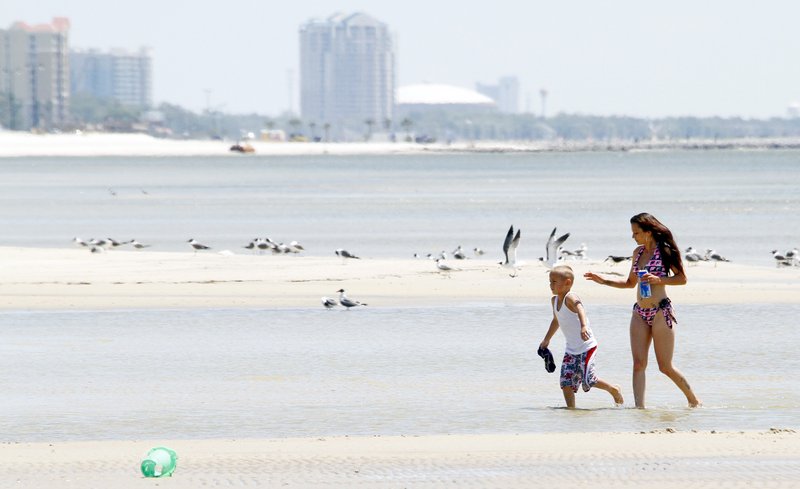BILOXI, Miss. – This time, it’s not a hurricane that threatens to wreck their livelihoods – it’s a blob of black ooze slowly making its way toward the Gulf Coast.
Hotel owners, fishermen and restaurateurs are keeping anxious watch as an oil slick spreads from a wrecked drilling platform like a giant filthy ink blot. Forecasters say it could wash ashore within days near delicate wetlands, oyster beds and pristine white beaches.
Crews have not been able to stop thousands of barrels of oil from spewing out of the sea floor since an April 20 explosion destroyed the Deepwater Horizon, which was drilling 50 miles off the Louisiana coast. Eleven workers are missing and presumed dead, and the cause of the explosion has not been determined.
Louis Skrmetta, 54, runs a company called Ship Island Excursions that takes tourists to the Gulf Islands National Seashore, where white-sand beaches and green water create an idyllic landscape.
“This is the worst possible thing that could happen to the Mississippi Gulf Coast,” he said. “It will wipe out the oyster industry. Shrimping wouldn’t recover for years. It would kill family tourism. That’s our livelihood.”
As crews struggled to contain the oil slick, Coast Guard officials said Tuesday they were considering setting fire to the contaminated water to burn off the crude. Pools of oil far offshore would be trapped in special containment booms and set aflame as soon as Wednesday.
“If we don’t secure this well, this could be one of the most significant oil spills in U.S. history,” Coast Guard Rear Adm. Mary Landry said.
A similar burn off the coast of Newfoundland in 1993 eliminated 50 to 99 percent of captured oil. However, burning the oil also creates air pollution, and the effect on marine life is unclear.
According to the National Oceanic and Atmospheric Administration, birds and mammals are more likely to escape a burning area of the ocean than escape from an oil slick. The agency said birds might be disoriented by the plumes of smoke, but they would be at much greater risk from exposure to oil in the water.
In Washington, meanwhile, the Obama administration launched a full investigation of the explosion, and Homeland Security Secretary Janet Napolitano and Interior Secretary Ken Salazar said they will devote every available resource to the probe.
Meanwhile, the glistening sheen of sweet crude continued to grow and began forming long reddish-orange ribbons of oil that, if they wash up on shore, could cover birds, white sand beaches and marsh grasses.
The last major spill in the Gulf was in June 1979, when an offshore drilling rig in Mexican waters – the Ixtoc I – blew up, releasing 140 million gallons of oil. It took until March 1980 to cap the well, and a great deal of the oil contaminated U.S. waters and Texas shores.
“In the worst-case scenario, this could also last months,” said Richard Haut, a senior research scientist at the Houston Advanced Research Center who worked for Exxon for 20 years, 10 of them on an offshore platform in the North Sea.
Oil from the Deepwater Horizon is not expected to reach the coast until late in the week, if at all. As of Tuesday, it was about 20 miles offshore, south of Venice, La. The spill covered an expanding area about 48 miles long and 80 miles wide, but with uneven borders, making it difficult to calculate its area in square miles.
“I understand there’s got to be industry, but it’s so sad for our kids. We don’t have a lot of beaches left,” Bonnie Bethel, 66, said as she watched her grandchildren splash in the water on a Mississippi beach. “Can you imagine these poor birds in oil?”
Thousands of birds such as egrets and brown pelicans are nesting on barrier islands close to the rig’s wreckage right now. If the oil gets to them, rescuers would need to reach their remote islands, wash them down and release them back into the wild.
Michael Ziccardi, director of the Oiled Wildlife Care Network affiliated with the University of California at Davis, said he is standing by to clean up Gulf Coast birds if they are hurt by the spill. Cleaning up brown pelican chicks after a modest spill in Louisiana in 2005 was a major undertaking, he said.
“Just about any petroleum can cause problems for birds because they lose their waterproofing, and that’s what keeps them dry and warm,” Ziccardi said. “It’s a really difficult time, and we’re close to the peak of migration.”
The spill also threatens billions of fish eggs and larvae coating the Gulf’s surface this time of year.
If the well cannot be closed, almost 100,000 barrels of oil, or 4.2 million gallons, could spill into the Gulf before crews can drill a relief well to alleviate the pressure. comparison, the Exxon Valdez, the worst oil spill in U.S. history, leaked 11 million gallons into Alaska’s Prince William Sound in 1989.
Copy the Story Link
Send questions/comments to the editors.



Success. Please wait for the page to reload. If the page does not reload within 5 seconds, please refresh the page.
Enter your email and password to access comments.
Hi, to comment on stories you must . This profile is in addition to your subscription and website login.
Already have a commenting profile? .
Invalid username/password.
Please check your email to confirm and complete your registration.
Only subscribers are eligible to post comments. Please subscribe or login first for digital access. Here’s why.
Use the form below to reset your password. When you've submitted your account email, we will send an email with a reset code.